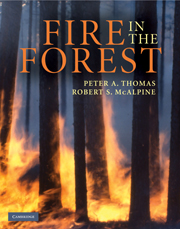Book contents
- Frontmatter
- Contents
- Preface
- List of contributors
- 1 In the beginning
- 2 Historical review
- 3 How a fire burns
- 4 Fire in the wild landscape
- 5 Fire ecology
- 6 The benefits of fire and its use as a landscape tool
- 7 Fire suppression
- 8 Wildland fire and its management – a look towards the future
- Further reading
- References used in the text
- Index
5 - Fire ecology
Published online by Cambridge University Press: 05 August 2012
- Frontmatter
- Contents
- Preface
- List of contributors
- 1 In the beginning
- 2 Historical review
- 3 How a fire burns
- 4 Fire in the wild landscape
- 5 Fire ecology
- 6 The benefits of fire and its use as a landscape tool
- 7 Fire suppression
- 8 Wildland fire and its management – a look towards the future
- Further reading
- References used in the text
- Index
Summary
When considering forest fires and the survival of plants and animals there is a glaring paradoxical imbalance. A flame has a temperature of around 800–1200 °C whether it is the gentle flame of a match or candle, or a raging forest fire (see Chapter 3 for a longer discussion), and physiologically active living tissue (plant or animal) is killed by a short exposure to temperatures above 50–60 °C.
A burning forest does not consist of solid flame, so inevitably the temperature inside the forest is not uniformly that of a burning flame. Hot air rises, dragging in colder air near the ground from the sides. Thus although the centre and top of a burning canopy may be above 1000 °C, temperatures may be expected to reduce with height to perhaps just a few hundred degrees, unless there is a marked radiation of heat downwards from burning fuel above ground level (such as in dense shrubbery). Even so, temperatures above 100 °C may persist for up to several minutes near the ground, especially if the ‘burnout time’ is long (see Box 5.1). The main key to surviving forest fires is to keep the heat of the flame away from living tissue. How this is done very much depends on whether you are considering plants or animals, and if looking at plants, what sort of fire is burning – whether it is a ground fire, a surface fire or a crown fire. Some plants will also continue via seeds if the parent is killed.
- Type
- Chapter
- Information
- Fire in the Forest , pp. 90 - 118Publisher: Cambridge University PressPrint publication year: 2010



